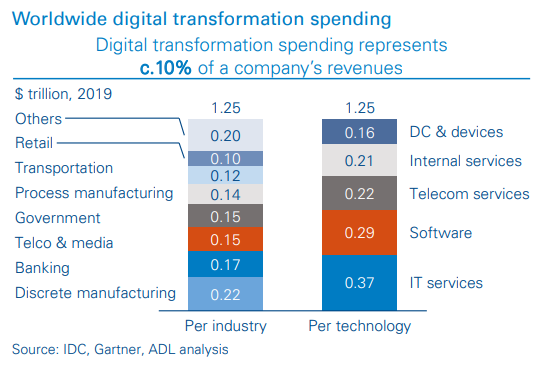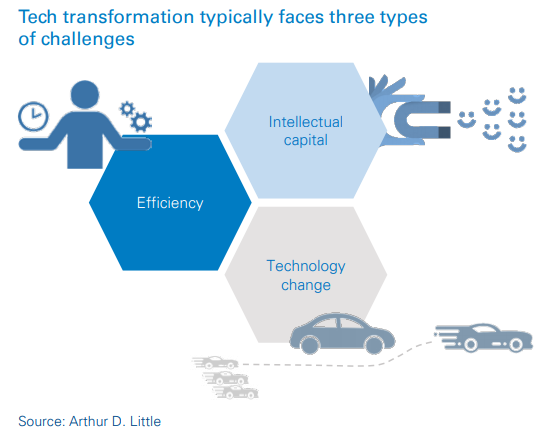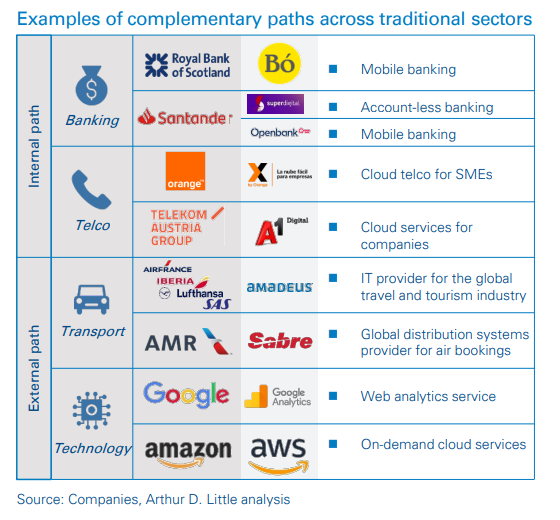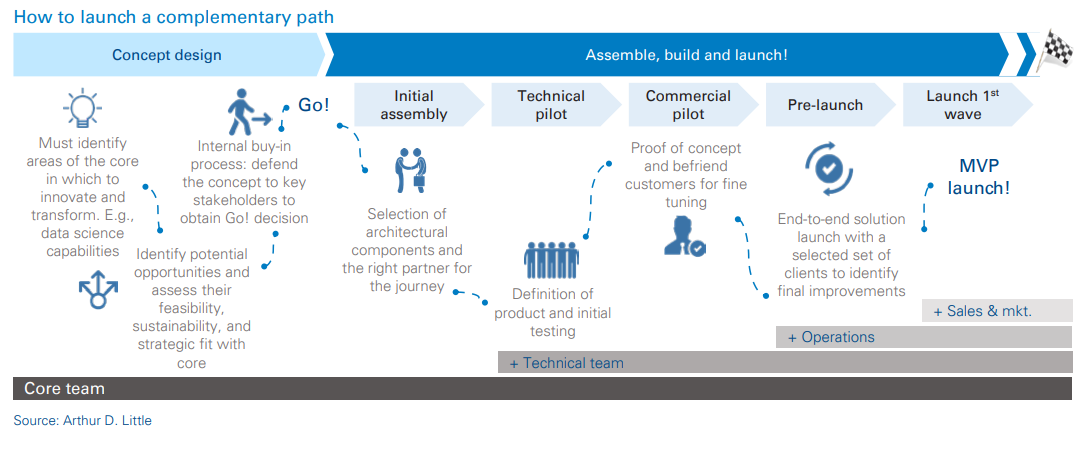
DOWNLOAD
DATE
Contact
Digital competitors have raised the bar and are forcing incumbents from virtually every industry into huge transformation programs. To win this race for digitalization, incumbents are investing vast amounts of resources into multi-year programs that require them to change the engine with the train still rolling. This requires executive teams to manage many challenges and produce multiple results that are either different than expected or diluted. We recommend that companies explore complementary paths to avoid transformation projects becoming too large and too broad or complex, while allowing transformation teams to focus on the fundamental business issues. Complementary paths accelerate returns, are more manageable, require less resources to be launched, and allow the organization to try and fail without risking too much. In this Viewpoint, we explain how complementary strategies can help company transformations succeed in an era of fast change.
Incumbents are facing the same situation
Incumbents around the world are facing the same situation, regardless of sector. Digital competitors and newborn greenfield players are raising the bar in many fields, improving customer experience, introducing new business models and accelerating the speed of innovation. Furthermore, digital-native firms are attracting the best talent beyond the technology field. On top of that, they are more efficient, which is allowing them to redefine the term scale. This pressure pushes incumbents to undertake large and difficult transformation programs based on new technologies and ways of working. Dedication of resources to technology and innovation is growing in incumbent companies across all industries, at 16 percent on average – much faster than revenues.
Worldwide, incumbents’ spend on transformation programs represents circa $1.25 trillion, as shown in the below figure. This sum represents around 10 percent of their annual revenues. To compensate for transformation investments, companies seek additional efficiencies derived mainly from operations automation and removal of legacy systems. Both levers are difficult to activate and require significant efforts.
Furthermore, few incumbent companies are claiming successful transformation of core legacy operations into truly agile and efficient digital operations.

Many CxOs are at crossroads
Large transformation initiatives involve challenges that executives need to avoid and contain, as shown in below figure.
Transformation programs usually take three to five years and, very often, results are different than expected because the initial scope and focus evolve.
Transformation programs usually engage the best talent available in the company, who are then distracted from the day-to-day business. Furthermore, these programs require companies to take on the challenge of building new capabilities.
Companies that wish to transform must select and effectively adopt new technologies that evolve quickly, with technology cycles that become faster and faster. This forces them to undertake painful migration and rearchitecture projects to continuously upgrade the newborn legacies.
The business case for transformation requires the company to achieve relevant efficiencies in order to be approved. However, it is difficult to avoid overruns in large programs, due to their threeto five-year time scales and the many variables involved.

Transformation is never an easy journey; executives involved in these initiatives will never question that. Transforming a complex, multinational organization in motion is very difficult. However, it is a crucial step for the company to remain competitive. To maximize the odds of acquiring new capabilities and developing new value propositions, incumbents across several sectors are launching smaller and more focused initiatives with great ambitions.
We call these initiatives complementary paths, as they will evolve in parallel with a company’s core transformation initiative without distorting it. Instead, complementary paths will derive positive externalities that will be easily transferable to the company’s core business.
Complementary paths can help minimize risks and accelerate returns
Many companies have launched initiatives that rely on new technologies to explore new opportunities. Examples of these include Daimler Mobility Services, which offers applicationbased mobility services, and Orange, which recently launched a mobile-banking service. These parallel initiatives can bring high value to the company in terms of new capabilities or data. However, in the long run, this will not result in a sustainable lever for the company’s core transformation, as these initiatives are geared towards the development of business extensions.
A true complementary path has to be directly linked to the company’s core technology platform. Furthermore, if the complementary path develops successfully, it will support transformation of the company’s technology, processes, culture and business model. The final goals of these initiatives may vary a lot; however, they will always produce new capabilities and intellectual capital that are transferable to the core business. Or they may even result in a new platform to migrate specific client segments or the entire portfolio.
We foresee two types of complementary paths. A standard complementary path is considered an internal path, in which the underlying technology platform is closed and only supports the initiative. When the opportunity is developed on top of a technology platform that is made available to third parties, we consider this an external path, as the technology is open.
Some players are launching internal paths across the telecoms and banking sectors, as shown in the below figure. Santander’s SuperDigital account-less bank in Latin America, as well as its Openbank service in Spain, are based on next-generation platforms. Orange recently launched X by Orange, a cloud-native operator focused on SMEs, also in Spain.
The market has pursued external paths for decades. Airlines were pioneers in collaborating on large technology projects and opening them to third parties to join efforts and share the burden, which resulted in the creation of Sabre and Amadeus. More recently, technology companies followed a similar strategy to better leverage their IT infrastructure so they could grow to hyper-scale to support their core businesses. Amazon launched AWS by leveraging its hyper-scale data-center infrastructure to support the largest global e-commerce platform.

Companies seeking to develop complementary strategies can follow multiple paths, as described earlier. From our benchmarking exercise across the industries (reflected in the above figure) we have classified the key objectives that follow these initiatives into the following categories:
- Accelerate new technology and innovation adoption.
- Increase flexibility, scale and agility.
- Attract talent and new capabilities.
- Leverage data to improve customer experience, automation, decision-making, etc.
- Diversify geographies, products, etc.
- Develop efficient technology platforms.
How to develop a complementary path and succeed
Developing a complementary path requires the company to first identify a sustainable and feasible opportunity directly related to its core business. Second, a complementary path requires it to do things in a different way, otherwise the ambition will not be fully achieved and execution is likely to fail.
- A company must clearly identify the underlying objectives of its core transformation, e.g., reach out to new customers or drastically reduce the cost to serve existing customers. Once this goal is clear, the executive needs to identify a potential business opportunity and assess its feasibility, sustainability, and strategic fit with the core. Right after that, the project team must initiate the internal buy-in process, a difficult task that requires defending the concept and the business case to key stakeholders in the company, with the objective of obtaining the “Go! decision”
- After the “Go! decision”, a few more steps are required before the first product launch:

- Initial assembly: Selection of architectural components’ key partners, from technology to commercial fields. Tasks to perform include validating the concept among partners and defining the ecosystem/collaboration model.
- Technical pilot: Basic solutions testing for the initial product. A technical team needs to be built and the product portfolio defined.
- Commercial pilot: Proof of concept of the company’s product with befriended customers.
- Prelaunch: The complete, end-to-end solution distributed among a selected set of customers, free of charge, to expose any gaps or improvements. Service orchestration and automation will be a top priority.
- Launch first wave: Launch of the MVP!
Lastly, certain requirements will allow the development of the complementary paths to succeed:
- Support from a relevant internal sponsor is paramount for the initiative to develop.
- There must be an autonomous supplier model in place to allow higher supplier flexibility and work with new partners.
- The whole team must acquire a collective “start-up mentality”; results will be different only through new and different processes.
- Finally, the initiative should have enough autonomy to grow fast, with minimum steering to ensure the right direction.
It is necessary to re-emphasize the relevance of the internal sponsor to guarantee the complementary project’s success. The internal sponsor should be a credible stakeholder with enough power to get things done in the organization, usually a CxO position or executive committee member. The sponsor, together with the steering committee, will define the targets and the timeline to accomplish them. Furthermore, the sponsor must regularly ensure that the project gets the required resources, and that development is aligned with the defined plan and targets.
Insight for the executive
- Complementary paths should allow for positive externalities, and these should be easily transferable to the company’s core business.
- It is critical to provide complementary-path opportunities for their own development space. Otherwise, delays and lack of traction and momentum can be expected.
- In addition to pursuing core-transformation projects, complementary paths offer an easy way to acquire new digital capabilities and intellectual capital, which can be spread across the organization with high impact and low risks. In other words, it allows them to learn more, faster, and risk less.
- At Arthur D. Little we are passionate about innovation and real step changes. In addition, to support our clients in their core-business strategies and transformation initiatives, we work with them to establish complementary paths that accelerate change and innovation, as well as bring highimpact returns that are almost automatically transferable to their cores.



